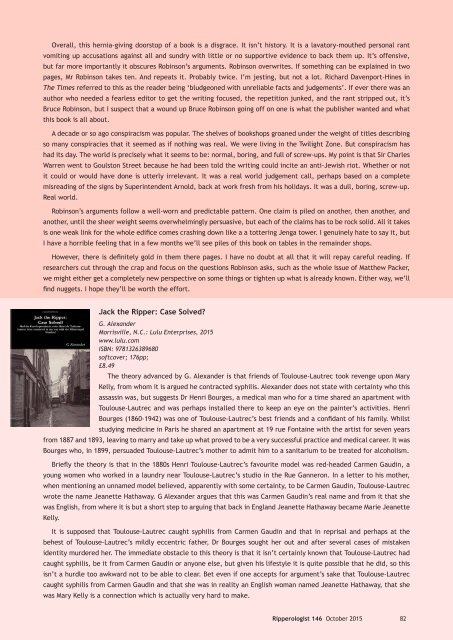GEORGE HUTCHINSON
orxwju5
orxwju5
Create successful ePaper yourself
Turn your PDF publications into a flip-book with our unique Google optimized e-Paper software.
Overall, this hernia-giving doorstop of a book is a disgrace. It isn’t history. It is a lavatory-mouthed personal rant<br />
vomiting up accusations against all and sundry with little or no supportive evidence to back them up. It’s offensive,<br />
but far more importantly it obscures Robinson’s arguments. Robinson overwrites. If something can be explained in two<br />
pages, Mr Robinson takes ten. And repeats it. Probably twice. I’m jesting, but not a lot. Richard Davenport-Hines in<br />
The Times referred to this as the reader being ‘bludgeoned with unreliable facts and judgements’. If ever there was an<br />
author who needed a fearless editor to get the writing focused, the repetition junked, and the rant stripped out, it’s<br />
Bruce Robinson, but I suspect that a wound up Bruce Robinson going off on one is what the publisher wanted and what<br />
this book is all about.<br />
A decade or so ago conspiracism was popular. The shelves of bookshops groaned under the weight of titles describing<br />
so many conspiracies that it seemed as if nothing was real. We were living in the Twilight Zone. But conspiracism has<br />
had its day. The world is precisely what it seems to be: normal, boring, and full of screw-ups. My point is that Sir Charles<br />
Warren went to Goulston Street because he had been told the writing could incite an anti-Jewish riot. Whether or not<br />
it could or would have done is utterly irrelevant. It was a real world judgement call, perhaps based on a complete<br />
misreading of the signs by Superintendent Arnold, back at work fresh from his holidays. It was a dull, boring, screw-up.<br />
Real world.<br />
Robinson’s arguments follow a well-worn and predictable pattern. One claim is piled on another, then another, and<br />
another, until the sheer weight seems overwhelmingly persuasive, but each of the claims has to be rock solid. All it takes<br />
is one weak link for the whole edifice comes crashing down like a a tottering Jenga tower. I genuinely hate to say it, but<br />
I have a horrible feeling that in a few months we’ll see piles of this book on tables in the remainder shops.<br />
However, there is definitely gold in them there pages. I have no doubt at all that it will repay careful reading. If<br />
researchers cut through the crap and focus on the questions Robinson asks, such as the whole issue of Matthew Packer,<br />
we might either get a completely new perspective on some things or tighten up what is already known. Either way, we’ll<br />
find nuggets. I hope they’ll be worth the effort.<br />
Jack the Ripper: Case Solved?<br />
G. Alexander<br />
Morrisville, N.C.: Lulu Enterprises, 2015<br />
www.lulu.com<br />
ISBN: 9781326389680<br />
softcover; 176pp;<br />
£8.49<br />
The theory advanced by G. Alexander is that friends of Toulouse-Lautrec took revenge upon Mary<br />
Kelly, from whom it is argued he contracted syphilis. Alexander does not state with certainty who this<br />
assassin was, but suggests Dr Henri Bourges, a medical man who for a time shared an apartment with<br />
Toulouse-Lautrec and was perhaps installed there to keep an eye on the painter’s activities. Henri<br />
Bourges (1860-1942) was one of Toulouse-Lautrec’s best friends and a confidant of his family. Whilst<br />
studying medicine in Paris he shared an apartment at 19 rue Fontaine with the artist for seven years<br />
from 1887 and 1893, leaving to marry and take up what proved to be a very successful practice and medical career. It was<br />
Bourges who, in 1899, persuaded Toulouse-Lautrec’s mother to admit him to a sanitarium to be treated for alcoholism.<br />
Briefly the theory is that in the 1880s Henri Toulouse-Lautrec’s favourite model was red-headed Carmen Gaudin, a<br />
young women who worked in a laundry near Toulouse-Lautrec’s studio in the Rue Ganneron. In a letter to his mother,<br />
when mentioning an unnamed model believed, apparently with some certainty, to be Carmen Gaudin, Toulouse-Lautrec<br />
wrote the name Jeanette Hathaway. G Alexander argues that this was Carmen Gaudin’s real name and from it that she<br />
was English, from where it is but a short step to arguing that back in England Jeanette Hathaway became Marie Jeanette<br />
Kelly.<br />
It is supposed that Toulouse-Lautrec caught syphilis from Carmen Gaudin and that in reprisal and perhaps at the<br />
behest of Toulouse-Lautrec’s mildly eccentric father, Dr Bourges sought her out and after several cases of mistaken<br />
identity murdered her. The immediate obstacle to this theory is that it isn’t certainly known that Toulouse-Lautrec had<br />
caught syphilis, be it from Carmen Gaudin or anyone else, but given his lifestyle it is quite possible that he did, so this<br />
isn’t a hurdle too awkward not to be able to clear. Bet even if one accepts for argument’s sake that Toulouse-Lautrec<br />
caught syphilis from Carmen Gaudin and that she was in reality an English woman named Jeanette Hathaway, that she<br />
was Mary Kelly is a connection which is actually very hard to make.<br />
Ripperologist 146 October 2015 82




